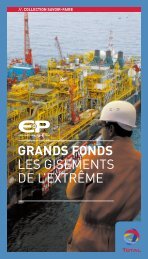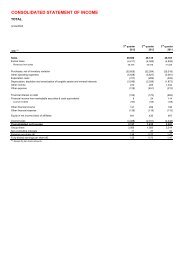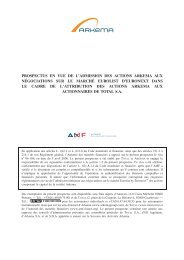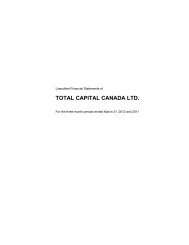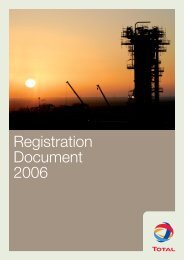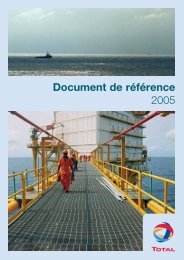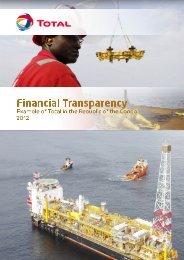Registration Document 2005 - Total.com
Registration Document 2005 - Total.com
Registration Document 2005 - Total.com
Create successful ePaper yourself
Turn your PDF publications into a flip-book with our unique Google optimized e-Paper software.
5<br />
Corporate Governance<br />
Report of the Chairman of the Board of Directors<br />
(Article L. 225-37 of the French Commercial Code)<br />
Internal control procedures<br />
The internal control guidelines adopted by TOTAL consist of<br />
the framework developed by the Committee of Sponsoring<br />
Organizations of the Treadway Commission (COSO). Within this<br />
framework, internal control is a process intended to provide<br />
reasonable assurance that the following goals will be achieved: the<br />
effectiveness and efficiency of the operations, the reliability of the<br />
financial information, and <strong>com</strong>pliance with the laws and regulations<br />
in force. Like any internal control system, it cannot, however,<br />
provide an absolute guarantee that every risk is <strong>com</strong>pletely<br />
eliminated.<br />
Therefore, the Group’s internal control system <strong>com</strong>plies with the<br />
framework of operations re<strong>com</strong>mended by the COSO: organization<br />
and principles of control, the risk evaluation process, control<br />
activities properly speaking, documentation and disclosure of<br />
control rules, and supervision of the control system.<br />
Organization and principles of control<br />
The Group’s control system is built around a three-level operational<br />
structure: Group, business segments and profit centers. Each level<br />
is directly involved in the design and implementation of the control<br />
based on the level of centralization desired by Management.<br />
At each of the three levels, internal control is structured into specific<br />
organizational procedures, a delegation of responsibilities, and<br />
employee training that reflects the general framework of the Group.<br />
The organization of the internal control is based first on key<br />
factors that are deeply rooted in its culture, including integrity,<br />
ethics and the <strong>com</strong>petence of the employees. The Group’s upper<br />
management is informed on a regular basis of the content and the<br />
importance of the conduct rules, which are formalized in a code<br />
of conduct available on the Group’s website. Each profit center<br />
or subsidiary operating and financial officer makes an annual<br />
<strong>com</strong>mitment to <strong>com</strong>ply with the internal control rules and the fair<br />
presentation of his financial information through a “representation<br />
letter” sent to the Group’s Chief Financial Officer.<br />
These control principles have been reaffirmed and formalized more<br />
<strong>com</strong>pletely to reflect the corporate governance approach described<br />
above.<br />
Risk evaluation process<br />
The identification and analysis of the risks that could impact the<br />
achievement of the Group’s objectives is the responsibility of the<br />
Executive Committee, which is assisted in this work by the Risk,<br />
Management Control and Internal Audit Committee.<br />
The principal risks monitored at Group-level are as follows:<br />
sensitivity to oil environment parameters (price of oil, refining and<br />
marketing margins and petrochemical margins), the risks related<br />
110 TOTAL - <strong>Registration</strong> <strong>Document</strong> <strong>2005</strong><br />
to the oil and gas markets in the trading business, the risks in the<br />
financial markets (foreign exchange risk, particularly the U.S. dollar<br />
risk, and the interest rate risk given the heavy capital <strong>com</strong>ponent<br />
of the Group’s businesses), legal and political risks generated<br />
by the operational context and the contractual dimension of the<br />
exploration and production operations, industrial and environmental<br />
risks arising from the nature of the Group’s businesses in general.<br />
A formal report on the principal risks and the management of those<br />
risks is provided in the section Risk factors in this <strong>Registration</strong><br />
<strong>Document</strong>.<br />
Control activities<br />
The control activities, particularly the financial reporting systems, are<br />
designed to take into account the specific nature of these risks and<br />
the level of delegation granted to the business sectors and profit<br />
centers.<br />
The Group’s Management exercises control on the operational<br />
level through the Group Executive Committee, which approves<br />
investments and expenditures based on thresholds it has defined.<br />
On the functional level, control is primarily based on a strategic<br />
plan revised annually, an annual budget, a monthly financial report<br />
that analyzes variances from the budget in detail, and the quarterly<br />
account consolidations that are reconciled with the report. These<br />
processes are supervised by the Budget-Management Control<br />
Department and the Accounting Department, and are conducted<br />
in <strong>com</strong>pliance with standardized financial reporting methods, which<br />
are harmonized and adapted to the accounting standards of the<br />
published financial statements. The choice of the financial indicators<br />
and accounting methods was dictated by the primary objective,<br />
which was to reflect the reality of the risks and measure the return<br />
on average capital employed (ROACE).<br />
The Group Department of Accounting monitors changes in<br />
accounting regulations on an ongoing basis, particularly changes in<br />
international accounting standards. As a result, in 2004, the Group<br />
revised its accounts to meet IFRS and adapted its control system<br />
to the resulting changes.<br />
The consolidated financial statements for <strong>2005</strong> have been prepared<br />
in accordance with accounting and valuation principles of the<br />
International Financial Reporting Standards (IFRS) as adopted by<br />
the European Union. In order to facilitate a <strong>com</strong>parison with the<br />
consolidated statements for 2004, the 2004 statements have been<br />
restated in accordance with the same principles.<br />
The Financing-Treasury Department monitors and manages the<br />
risks generated by cash activities and rate and currency financial<br />
instruments in accordance with the strict rules defined by the<br />
Group’s Management. Cash and cash equivalents, the positions<br />
and management of financial instruments are systematically<br />
centralized by the Financing-Treasury Department.




